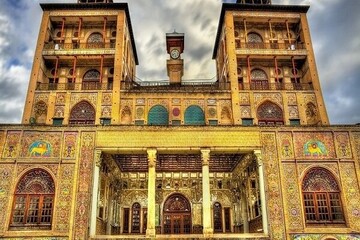Golestan Palace in Tehran is one of the most spectacular places you will visit on your travel to Iran. This great palace is a collection of valuable and oldest buildings that have been built and completed at various times. It is one of the most important monuments and palaces of the country and a fine example of Iranian art, history, and architecture.

Golestan Palace stands on the site of Tehran's Arg (citadel) which was originally built in the time of Shah Tahmasp I of the Safavid dynasty in the 16th century and was later renovated by Karim Khan of the Zand dynasty.
When Agha Mohammad Khan of the Qajar dynasty (1742–1797) chose Tehran as his capital, Golestan Palace became the official residence of the Shah, who rebuilt and completed it with new buildings.

The main changes were made during Naser al-Din Shah Qajar kingdom. The palace was rebuilt to its current form in 1865 by Haji Ab ol Hasan Mimar Navai. The buildings of Shams-ol-Emareh and the Emarat-e Badgir ( Windcatcher) are the buildings commissioned by Naser Al-din Shah, showing traces of a European architectural style and building technology that the king was influenced by on his travels.
During the Pahlavi era, Golestan Palace acted as a place for official events and receptions. They built their own, more modern palace in Niavaran in north Tehran. But the most important ceremonies were held in Golestan Palace, including the coronation of Reza Shah and the coronation of Mohammad Reza Pahlavi.

During the Reza Shah era, some of the buildings in Golestan Palace were destroyed between 1925 and 1945 as Shah strongly believed in the modernization of Iran.
The palace covers an area of 53000 m2 and consists of 17 structures, including palaces, museums, and halls.
Marble Throne, Brilliant Hall, Ivory Hall, Mirror Hall, Diamond Hall, Karim Khani Nook, Pond House, Containers Hall, Salam Hall, Building of Wind catchers and Shams-ol-Emareh are some of the main points of the palace. Now, here’s a summarized explanation of some of the above buildings’ functions:

The idea of building Shams-ol-Emareh came from Naser al-Din Shah’s first trip to Europe. He had decided to build a special palace inspired by the high structures he had seen in foreign countries.
Karim Khani Nook was once part of the residence of Karim Khan of the Zand dynasty. The structure of the Karim Khani Nook is similar to the Marble Throne.

Marble Throne was used for the coronation of Qajar kings and Reza Shah in 1925. Made from over sixty pieces of stone the raised dais is supported by carved human figures.
Mirror Hall is famous for its extraordinary mirror work and was constructed between 1874 and 1877.

Ivory Hall is a large hall used as a dining room. It was decorated with some gifts presented to Naser al-Din Shah by European monarchs.
The Pond House was used as a summer chamber during the Qajar era. Works of European painters presented to the Qajar court are housed at the Pond House.

Golestan palace is vibrant, colorful, and full of aesthetic ornate figures created by gifted Qajarian artists. This elegant garden was registered on the UNESCO world heritage list in 2013 because it is created by mixing Iranian fine art and European architecture and technology that became a phenomenon in Iranian history and culture.
It hosts several Iranian and foreign visitors every year due to its unique architecture as well as historical and artistic values.
There are numerous popular tourist sites located around the palace, such as Grand Bazaar, National Museum of Iran, Negarestan Garden, Masoudieh Palace, National Jewelry Museum, etc.


Your Comment